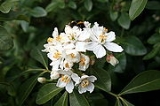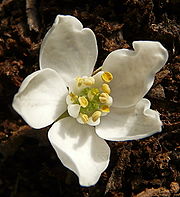
Choisya
Encyclopedia

Evergreen
In botany, an evergreen plant is a plant that has leaves in all seasons. This contrasts with deciduous plants, which completely lose their foliage during the winter or dry season.There are many different kinds of evergreen plants, both trees and shrubs...
shrub
Shrub
A shrub or bush is distinguished from a tree by its multiple stems and shorter height, usually under 5–6 m tall. A large number of plants may become either shrubs or trees, depending on the growing conditions they experience...
s in the rue
Rue
Rue is a genus of strongly scented evergreen subshrubs 20–60 cm tall, in the family Rutaceae, native to the Mediterranean region, Macaronesia and southwest Asia. There are perhaps 8 to 40 species in the genus...
family, Rutaceae
Rutaceae
Rutaceae, commonly known as the rue or citrus family, is a family of flowering plants, usually placed in the order Sapindales.Species of the family generally have flowers that divide into four or five parts, usually with strong scents...
. Members of the genus are commonly known as Mexican Orange or Mock Orange due to the similarity of their flowers with those of the closely related Orange
Orange (fruit)
An orange—specifically, the sweet orange—is the citrus Citrus × sinensis and its fruit. It is the most commonly grown tree fruit in the world....
, both in shape and scent. They are native to southern North America
North America
North America is a continent wholly within the Northern Hemisphere and almost wholly within the Western Hemisphere. It is also considered a northern subcontinent of the Americas...
, from the southwestern United States
Southwestern United States
The Southwestern United States is a region defined in different ways by different sources. Broad definitions include nearly a quarter of the United States, including Arizona, California, Colorado, Nevada, New Mexico, Oklahoma, Texas and Utah...
(Arizona
Arizona
Arizona ; is a state located in the southwestern region of the United States. It is also part of the western United States and the mountain west. The capital and largest city is Phoenix...
, New Mexico
New Mexico
New Mexico is a state located in the southwest and western regions of the United States. New Mexico is also usually considered one of the Mountain States. With a population density of 16 per square mile, New Mexico is the sixth-most sparsely inhabited U.S...
, Texas
Texas
Texas is the second largest U.S. state by both area and population, and the largest state by area in the contiguous United States.The name, based on the Caddo word "Tejas" meaning "friends" or "allies", was applied by the Spanish to the Caddo themselves and to the region of their settlement in...
) and south through most of Mexico
Mexico
The United Mexican States , commonly known as Mexico , is a federal constitutional republic in North America. It is bordered on the north by the United States; on the south and west by the Pacific Ocean; on the southeast by Guatemala, Belize, and the Caribbean Sea; and on the east by the Gulf of...
. In its generic name Humboldt and Bonpland honoured Swiss botanist Jacques Denis Choisy (1799-1859).
Description
The species grow to 1–3 m (3.3–9.8 ft) tall. The leavesLeaf
A leaf is an organ of a vascular plant, as defined in botanical terms, and in particular in plant morphology. Foliage is a mass noun that refers to leaves as a feature of plants....
are opposite, leathery, glossy, palmately
Leaf shape
In botany, leaf shape is characterised with the following terms :* Acicular : Slender and pointed, needle-like* Acuminate : Tapering to a long point...
compound with 3-13 leaflets, each leaflet 3–8 cm (1.2–3.1 in) long and 0.5–3.5 cm (0.196850393700787–1.4 in) broad. C. ternata has three broad leaflets, while C. dumosa has up to 13 very narrow leaflets. The flower
Flower
A flower, sometimes known as a bloom or blossom, is the reproductive structure found in flowering plants . The biological function of a flower is to effect reproduction, usually by providing a mechanism for the union of sperm with eggs...
s are star-shaped, 3–5 cm (1.2–2 in) diameter, with 4-7 white petal
Petal
Petals are modified leaves that surround the reproductive parts of flowers. They often are brightly colored or unusually shaped to attract pollinators. Together, all of the petals of a flower are called a corolla. Petals are usually accompanied by another set of special leaves called sepals lying...
s, 8-15 stamen
Stamen
The stamen is the pollen producing reproductive organ of a flower...
s and a green stigma; they are produced throughout the late spring and summer. The fruit
Fruit
In broad terms, a fruit is a structure of a plant that contains its seeds.The term has different meanings dependent on context. In non-technical usage, such as food preparation, fruit normally means the fleshy seed-associated structures of certain plants that are sweet and edible in the raw state,...
is a leathery two to six sectioned capsule
Capsule (fruit)
In botany a capsule is a type of simple, dry fruit produced by many species of flowering plants. A capsule is a structure composed of two or more carpels that in most cases is dehiscent, i.e. at maturity, it splits apart to release the seeds within. A few capsules are indehiscent, for example...
.
Uses
Choisya species are popular ornamental plantOrnamental plant
Ornamental plants are plants that are grown for decorative purposes in gardens and landscape design projects, as house plants, for cut flowers and specimen display...
s in areas with mild winters, grown primarily for their abundant and fragrant flowers. The foliage is also aromatic, smelling of rue
Rue
Rue is a genus of strongly scented evergreen subshrubs 20–60 cm tall, in the family Rutaceae, native to the Mediterranean region, Macaronesia and southwest Asia. There are perhaps 8 to 40 species in the genus...
when bruised or cut. The most commonly found cultivar
Cultivar
A cultivar'Cultivar has two meanings as explained under Formal definition. When used in reference to a taxon, the word does not apply to an individual plant but to all those plants sharing the unique characteristics that define the cultivar. is a plant or group of plants selected for desirable...
s in the horticultural trade are the golden-leaved C. ternata 'Sundance' and the inter-specific hybrid C. 'Aztec Pearl' (C. arizonica x C. ternata).
The flowers are also valued for honeybee forage, producing abundant nectar.
Chemistry
Many quinolineQuinoline
Quinoline is a heterocyclic aromatic organic compound. It has the formula C9H7N and is a colourless hygroscopic liquid with a strong odour. Aged samples, if exposed to light, become yellow and later brown...
alkaloids have been isolated from leaves of Choisya ternata.C. ternata contains an alkaloid (ternanthranin), a volatile simple anthranilate that can be considered responsible for the antinociceptive activity of the crude plant extracts.
Species
- Choisya dumosa (Torr.) A.GrayAsa Gray-References:*Asa Gray. Dictionary of American Biography. American Council of Learned Societies, 1928–1936.*Asa Gray. Encyclopedia of World Biography, 2nd ed. 17 Vols. Gale Research, 1998.*Asa Gray. Plant Sciences. 4 vols. Macmillan Reference USA, 2001....
– Starleaf - Choisya katherinae C.H.Müll.Cornelius Herman MullerCornelius Herman Muller was an American botanist and ecologist who pioneered the study of allelopathy.- Personal life :After graduating from the University of Illinois in 1938 with a Ph.D...
- Choisya ternata KunthCarl Sigismund KunthCarl Sigismund Kunth , also Karl Sigismund Kunth or anglicized as Charles Sigismund Kunth, was a German botanist...
– Mexican Orange Blossom
Pests and diseases
Choisya can be prone to attack by pythiumPythium
Pythium is a genus of parasitic oomycete. Most species are plant parasites, but Pythium insidiosum is an important pathogen of animals...
root rot, particularly when propagated and grown in pots for the horticultural trade. In north-west Europe the main pest is snails, which eat the bark of even mature specimens, resulting in minor die-back of branches where ring-barking
Girdling
Girdling, also called ring barking or ring-barking, is the complete removal of a strip of bark from around the entire circumference of either a branch or trunk of a woody plant. Girdling results in the death of wood tissues beyond the damage...
has occurred.

